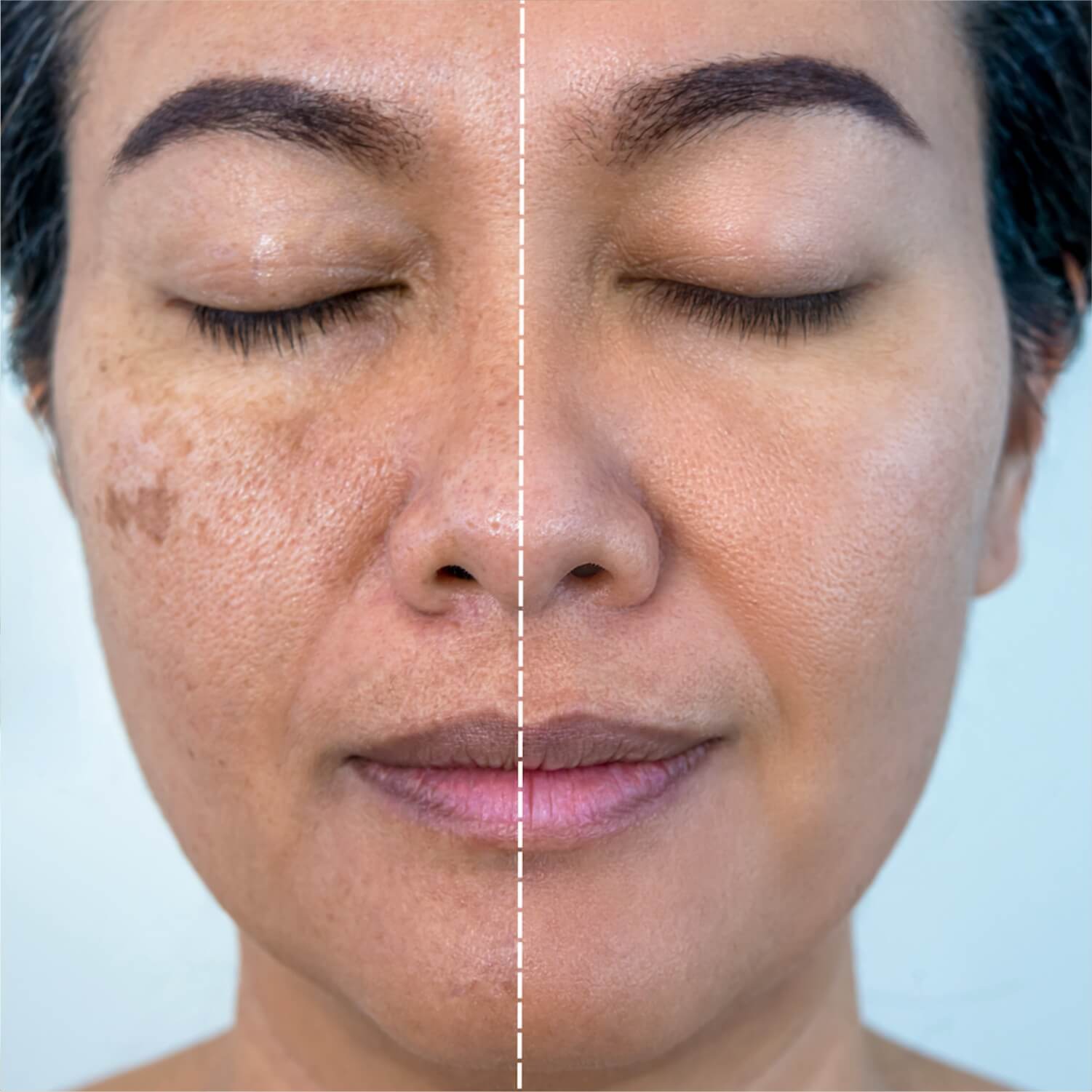Melasma Treatment in Navi Mumbai
Melasma is a common skin condition characterized by dark, irregular patches typically appearing on the face, particularly on the cheeks, forehead, upper lip, and chin. It primarily affects women and is often triggered by hormonal changes, sun exposure, or genetics. Melasma isn’t harmful, but it can cause distress due to its noticeable appearance. It’s sometimes referred to as “the mask of pregnancy” because it frequently occurs during pregnancy. Treatment options include topical medications, chemical peels, and laser therapy, although results vary. Sun protection is crucial in managing melasma to prevent the worsening of pigmentation.
Visit Niomi Aesthetic Clinic in Navi Mumbai for effective melasma treatment. Our skilled dermatologists offer personalized solutions tailored to your skin type and condition. Using advanced technologies and clinically proven methods, we aim to reduce pigmentation and even out skin tone. Our treatments are safe, non-invasive, and designed to deliver visible results. Trust Niomi Aesthetic Clinic for professional care and expertise in managing melasma.
Treatment Option for Melasma in Navi Mumbai
Melasma is a common skin condition characterized by brown to gray-brown patches on the face, often on the cheeks, bridge of the nose, forehead, chin, and above the upper lip. Treatment typically involves a combination of topical medications, procedures, and lifestyle changes. Here are some common treatment options:
Topical Treatments:
- Hydroquinone: It’s a skin-lightening agent that can lighten the skin. Available over-the-counter or as a prescription.
- Tretinoin and Corticosteroids: These can be used in combination with hydroquinone to enhance its effectiveness.
- Azelaic Acid: Another topical agent that may help lighten the skin.
- Kojic Acid: Found in some over-the-counter skin-lightening products.
- Vitamin C: Applied topically, it may help reduce the appearance of dark spots.
Procedures:
- Chemical Peels: Peels containing glycolic acid or trichloroacetic acid can help lighten the skin.
- Microdermabrasion: This procedure exfoliates the skin, helping to reduce the appearance of melasma.
- Laser Therapy: Various types of lasers can target and lighten the affected areas.
- Intense Pulsed Light (IPL) Therapy: This targets melanin and can help lighten melasma patches.
Oral Medications:
- Tranexamic Acid: Taken orally, it may help reduce melanin production.
- Oral Antioxidants: Some studies suggest that certain antioxidants, like polypodium leucotomos extract, may be beneficial.
Sun Protection:
- Sunscreen: Daily broad-spectrum sunscreen use (SPF 30 or higher) is crucial to prevent further darkening of melasma patches. Look for physical blockers like zinc oxide or titanium dioxide.
- Sun Protection Measures: Hats, sunglasses, and avoiding peak sun hours can also help prevent the worsening of melasma.
Cosmetic Camouflage:
- Makeup: High-quality makeup products can help conceal melasma patches.
Types of Melasma
Melasma is a common skin condition characterized by patches of dark, pigmented skin, typically on the face. There are different types of melasma based on their patterns and causes:
- Epidermal Melasma: Appears as brown patches on the surface of the skin and is the most common type. It’s often triggered by sun exposure.
- Dermal Melasma: This type appears deeper in the skin and is more challenging to treat. It appears as bluish-gray patches.
- Mixed Melasma: A combination of both epidermal and dermal melasma, with pigmentation occurring in both the superficial and deeper layers of the skin.
- Centrofacial Melasma: Characterized by patches of pigmentation on the central areas of the face, including the forehead, cheeks, nose, and upper lip.
- Malar Melasma: Also known as butterfly melasma, it appears as symmetrical patches on the cheeks and nose, resembling the shape of a butterfly.
Benefits of Melasma Treatment
- Improved Skin Appearance: Melasma treatment helps to reduce the appearance of dark patches on the skin, leading to a more even complexion and boosting overall skin appearance and confidence.
- Increased Self-Esteem: Successful treatment of melasma can significantly enhance self-esteem and confidence levels, as individuals feel more comfortable and satisfied with their skin’s appearance.
- Prevention of Worsening: Treating melasma can prevent the condition from worsening over time. Early intervention can stop the dark patches from becoming more pronounced and difficult to treat.
- Enhanced Quality of Life: Melasma treatment not only improves physical appearance but also positively impacts mental well-being, leading to a better quality of life by reducing stress and anxiety related to skin concerns.
- Protection from Sun Damage: Many melasma treatments involve sun protection measures, which not only help in treating existing melasma but also prevent its recurrence by shielding the skin from harmful UV rays, thus promoting long-term skin health.
Symptoms of Melasma
- Hyperpigmented Patches: Dark, irregularly shaped patches on the skin, usually brown or grayish-brown in color, commonly appearing on the face, particularly on the cheeks, forehead, upper lip, and chin.
- Symmetrical Patterns: Melasma often occurs symmetrically on both sides of the face, meaning if you have it on one cheek, you’re likely to have it on the other as well.
- Increased Pigmentation in Sun-Exposed Areas: The patches tend to darken after sun exposure and may fade in the winter months or with reduced sun exposure.
- Diffuse Borderlines: The borders of the patches may be indistinct or have a blurred appearance, blending into the surrounding skin.
- Variation in Depth of Pigmentation: Melasma can vary from superficial to deep pigmentations in the skin layers, resulting in different shades of discoloration.
- No Other Physical Symptoms: Melasma usually doesn’t cause any other physical symptoms like itching or pain. It’s primarily a cosmetic concern.

Frequently Asked Questions
The timeline for seeing results can vary depending on the severity of melasma and the chosen treatment plan. In many cases, noticeable improvements can be seen within a few weeks to a couple of months.
While Melasma Treatment can significantly improve the appearance of melasma, it may not provide a permanent cure. Melasma is a complex condition influenced by various factors, including hormones and sun exposure.
Depending on the chosen treatment modalities, potential side effects may include temporary redness, mild irritation, dryness, or flaking of the skin. These effects are generally mild and subside within a few days to weeks.
A: Melasma Treatment can be tailored to suit different skin types. However, individuals with darker skin tones may have a higher risk of post-inflammatory hyperpigmentation or other pigmentary changes.
A: Depending on your specific needs and skin condition, combining Melasma Treatment with other procedures may be beneficial. For example, combining chemical peels with laser therapy or micro-needling can enhance the overall results.
